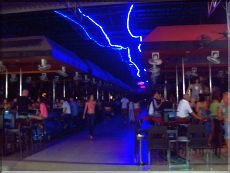

Beginning frames showing the early phase of Syp1 have been trimmed. (E) Tile views showing timing of appearance and disappearance of Syp1-GFP with End3-Cherry (SL5862) or Syp1-GFP with Abp1-RFP (SL5806). Syp1-GFP disappears just prior to Abp1-RFP appearance. Note the nearly complete overlap of Syp1-GFP and Ede1-Cherry, whereas End3-Cherry appears near the end of the fluorescent lifetime of Syp1. Exposures were 1 sec for GFP and Cherry fusions 800 msec for Abp1-RFP, with 3 sec between frames. (D) Kymographs from time lapse movies of Syp1-GFP combined with Ede1-Cherry (SL5863), End3-Cherry (SL5862), or Abp1-RFP (SL5806). There is essentially no overlap between Syp1-GFP and Abp1-RFP. Note yellow in the merge shows nearly complete overlap of Ede1 and Syp1, with only occasional overlap for Syp1-GFP and End3-Cherry (arrowheads).

Exposures were 1 sec for GFP and Cherry fusions 800 msec for Abp1-RFP. (C) Localization of Syp1-GFP combined with Ede1-Cherry (SL5863), End3-Cherry (SL5862), or Abp1-RFP (SL5806) in a single cross-section plane.

#F bar complex Patch
(B) Patch lifetimes ± standard deviation of indicated endocytic factors were obtained from 4 min time lapse movies taken at 600 msec exposures, 2 sec between frames. A Z-stack of 0.25 uM sections (600 msec exposures) was deconvolved and projected onto a single plane. Also highlighted are serine (Blue) and proline (Yellow) rich regions, possible Ark/Prk phosphorylation sites (T576, T588) and an NPF motif (Orange). (E) Schematic of Syp1 demonstrating regions of homology to F-BAR (Green) or AP μ (Brown) domains. (D) ARP2, arp2-1 and arp2-7 strains containing SYP1 or syp1Δ were 5-fold serially diluted and grown at 30☌, 35.5☌ or 37☌ for 48 hours. Transformants were 10-fold serially diluted, plated on selective medium, and grown at 25☌ and 37☌. (C) Previously identified high copy suppressors of pfy1Δ were transformed into the arp2-7 (BGY142) strain (BGY142). (B) ARP2 (BGY134), arp2-1 (BGY136), and arp2-7 (BGY142) strains transformed with empty vector (pBG006) or p GAL1-SYP1 (pBG287) were 10-fold serially diluted, plated on selective galactose-containing medium, and grown at 25 and 37☌. cerevisiae genomic inserts contained in library plasmids pJD11, pJD12, pJD7 and pJD9, which were isolated as high copy suppressors of arp2-7 temperature sensitive growth. Together, these data identify Syp1 as a novel negative regulator of WASp-Arp2/3 complex that helps choreograph the precise timing of actin assembly during endocytosis. This activity was mapped to a fragment of Syp1 located between its F-BAR and AP-2micro homology domains and depends on sequences in Las17/WASp outside of the VCA domain. Further, purified Syp1 directly inhibited Las17/WASp stimulation of Arp2/3 complex-mediated actin assembly in vitro. Overexpression of SYP1 in arp2-7 cells slowed Sla1-GFP lifetimes closer to wild-type cells. We performed a screen for multicopy suppressors of arp2-7 and identified SYP1, an FCHO1 homolog, which contains F-BAR and AP-2micro homology domains. Sla1-GFP and Abp1-RFP lifetimes were accelerated in arp2-7 mutants, which is opposite to actin nucleation-impaired arp2 alleles or deletions of Arp2/3 activators. We examined endocytosis in arp2-7 mutants by live-cell imaging of Sla1-GFP, a coat marker, and Abp1-RFP, which marks the later actin phase of endocytosis. To address this, we analyzed the yeast arp2-7 allele, which is biochemically unique in causing unregulated actin assembly in vitro in the absence of Arp2/3 activators. Although many Arp2/3 complex activators have been identified, mechanisms for its negative regulation have remained more elusive. Actin polymerization by Arp2/3 complex must be tightly regulated to promote clathrin-mediated endocytosis.


 0 kommentar(er)
0 kommentar(er)
